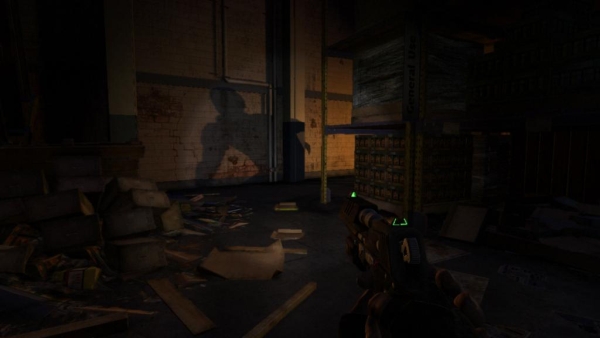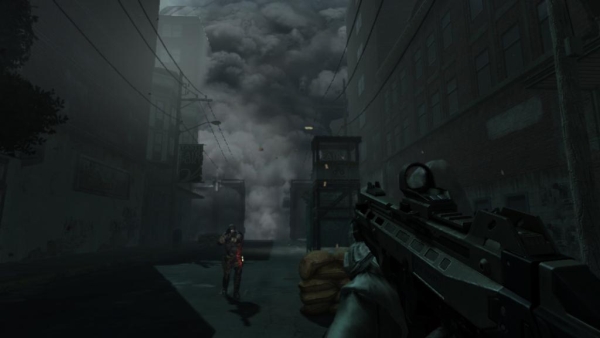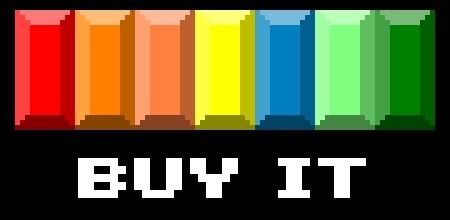
F.E.A.R. 3 is the latest installment in the F.E.A.R. series, which stands for First Encounter Assault Recon – although it doesn’t really seem like anyone cares what it stands for anymore, seeing as that hasn’t really been relevant since the first game. While not helmed by the original developers – Day 1 Studios has taken over for Monolith Productions – the latest in the popular horror franchise still has the same spirit as the two original games.
The most interesting addition to the family gameplay is co-op – players can either play the campaign alone as Point Man and unlock his brother, Paxton Fettel, as they go through each chapter, or they can play the game cooperatively with a friend either online or from their couch. Couch co-op has never been so fun – or so terrifying. The main fear I had was that Day 1 Studios wouldn’t be able to deliver, but I’m happy to announce that they’ve given birth to something… well, something more beautiful than what’s about to come out of Alma Wade, for certain.
Platforms: PC, PS3 (Version Played), Xbox 360
Publisher: WB Games
Developer: Day 1 Studios
Genre: FPSS – Freaky Pregnant Supernatural S***
Release Date: June 21, 2011
ESRB Rating: Mature
F.E.A.R. 3 continues the story of psychic Alma Wade, her children Point Man and Paxton Fettel from the original F.E.A.R., and Delta Force operative Michael Becket from F.E.A.R. 2. Spoiler alert: Point Man killed Fettel at the end of the first game, and Alma raped Becket at the end of the second. Now, it’s nine months later, and Alma’s getting ready to give Point Man and Fettel another sibling – if she lives that long. Fairport, where she’s being held, is falling apart – psychic energy is driving the citizens insane, sinkholes and monsters are appearing everywhere, and Alma’s “contractions” are messing with navigation and communication systems. It’s a race for Point Man and Fettel to get to Alma before everyone else does – and their intentions unravel as the story progresses.
The game is broken up into intervals, each of which takes you one step closer to finding Point Man and Fettel’s mother. They’re interspersed with memories from their childhood – a childhood full of pain and fear. For the first time, we’re shown the two characters as brothers growing up; we see what they went through and how they were treated. This insight is the first time they’re painted in a sympathetic light, and it feels almost strange to feel pity for them – and to even begin to cheer them on as the story unfolds. The writers have turned everything upside-down, bringing a brand new dimension and taking it to an emotional place it’s never been before.
Much of the gameplay is familiar. The controls are the same as they were in previous F.E.A.R. games, with the return of everything you love – including everyone’s favorite slo-mo. Gone is the interactive cover option – players can go into cover, but they can’t create the cover by flipping tables over as they could in F.E.A.R. 2. Still, the intuitive controls are extremely useful, especially when Armacham soldiers are ganging up on you, crazed citizens of Fairport with bombs strapped to their chests are jumping at you, or denizens from another plane are falling on your face.
Also familiar are the strategic elements at work in the shootouts, especially the more intense ones. The F.E.A.R. series is no stranger to this kind of strategy. Players must consider their environment carefully, and incorporate cover and combustible objects, while also figuring out which guns – and grenades – are best for each situation. Each well thought-out level feels like it’s been designed with strategy in mind. While many shooters incorporate these aspects, not all of them do so successfully, and not many horror games include strategy at all. Whereas many other horror games focus on the scare as well as the desperation of running out of ammo, the F.E.A.R. games make you think each battle through, bringing it to the level of franchises like Killzone, Resistance, and SOCOM.

Tied in with all of these elements is, of course, the horror itself. F.E.A.R. 3 is the best looking in the series – especially the cutscenes, which have a high production value. With John Carpenter as the creative consultant, the fear element was high. There were several moments when I did actually scream, scaring my cats and probably my neighbors. While not as terrifying as the first two games, it definitely has its frightening moments. Well-placed Almas (sometimes as a creepy child, sometimes as a terrifyingly pregnant and bloody adult) and amazingly atmospheric music set the tone. My anxiety levels weren’t as high playing this third installment – but I think it’s also difficult to trick players once they’ve been tricked before. In F.E.A.R. 2, I can still remember how tense I was when I awoke in a hospital with no weapon, and heard people arguing and fighting all around me. I kept saying “I need a gun, I need gun!” But when I had moments without a weapon in F.E.A.R. 3, while I did feel completely naked, I was confident I would find one quickly. It was difficult to be as anxious when I had already been in that situation before, and also because the situation itself was less stressful than it had been then. There’s also much less fear involved if you’re playing the game cooperatively with your brother, Fettel.
This brings me to the absolutely best part of the entire game: playing it cooperatively as the two brothers. I’ve had a lot of cooperative experiences, but I don’t think I’ve ever had as much fun playing couch co-op than I did playing F.E.A.R. 3 with Mike Gutierrez. After playing the entire game through as Point Man, I went through as Fettel while he took over as the silent protagonist. Fettel’s controls are different – he can hold enemies up in the air for his brother to shoot, hit them with psychic energy, perform a brutal melee, and – the best part – he can take over bodies, which then allows him to use whatever guns or primitive weapons the person has on them. The possession only lasts a short while, but Fettel can pick up blobs of blood suspended over fallen enemies to extend it. Possession also allows him to use mechs, which is a lot of fun. Fettel’s maniacal laugh when he took over a body made me crack up almost every time I heard it. It was an incredible feeling to possess an enemy right in the center of a group and then just open fire on everyone, especially with that laugh ringing in my ears.
I can’t emphasize enough here how incredibly fun it is to play this game cooperatively. Whether you’re playing couch co-op with a friend or playing online over the network, it brings an easy sense of teamwork, while still keeping that survival horror edge. The tension between the two brothers in the story adds depth to everything as well, making your choices feel more personal, and giving you a choice between teaming up with and helping your brother, or trying to hinder him as much as possible. It’s a unique experience not quite like any other I’ve ever had in a game, and it’s one that I thoroughly enjoyed.
Two other new additions to the campaign are the collectibles and challenges, all of which give you experience and allow you to get your Rank up, which gives you more bonuses (like longer slo-mo, less damage from hits, etc). Each level has an Alma Doll on it that you can collect – creepy little red dolls that disappear in a puff of smoke when you pick them up. There are also Psychic Links which you can collect – dead bodies scattered around the levels that are in a strange reddish mist. You can keep them for yourself or share them in co-op. The challenges have a huge range, from getting a certain number of headshots to spending a specific amount of time in cover to destroying helicopters. Completing challenges doesn’t just help you Rank up, either – it stacks up your points against your brother’s points, and bestows the “Favorite Son” award on whoever gets the most points. These points do change the outcome of the ending, so be sure to keep that in mind.

Not new to the series, but with a brand new spin, is the multiplayer. There are four modes available here, each one crazier than the last – F**king Run, Contractions, Soul King, and Soul Survivor. In F**king Run, players must run through the level and fight their way through wave after wave of enemies, as behind them Alma’s “Wall of Death” looms. Running down alleys for ammo, taking wrong turns, and getting hurt can easily end the level quickly. If a player falls, someone else can revive them, but once a player is consumed by the wall, the game is over. Tension can run high here, but the satisfaction of working together is also very rewarding.
Contractions is similar to Call of Duty’s Zombie modes, as it has you barricaded with three other players, fighting wave after wave of enemies, with a break in between to stock up on supplies. As the waves of enemies get tougher, the fog gets thicker, increasing the difficulty even more. In Soul King, all of the players are Spectres, and must possess enemies and collect souls dropped when enemies are killed. This mode can be chaotic and downright hilarious as you compete with your friends. In Soul Survivor, one player is the Spectre, and they must possess enemies in order to turn the other players into Spectres as well. Each game type has high entertainment value and has sucked me in for hours at a time.
One additional thing that is also typical for this series but worth mentioning here is the AI in the game. Many developers brag about how great their AI is, but the AI in the F.E.A.R. games is truly exceptional. I can feel the almost subtle shift in sensitivity when playing the difficulties – the AI doesn’t suddenly know every single time you move when you play it on the more difficult modes, but it’s also not dumber than a rock in the easier ones. This devotion to having challenging and satisfying AI continues to impress in this game, even with a change in developers.
The only major complaint that I have is that playing the game solo can be frustrating at times. Some of the enemies can be unrelentingly difficult, and there are more than a few checkpoints that are unforgiving. What took me over a dozen tries by myself took far less time with a friend. In fact, it seems like the game was made to be played cooperatively. Originally, the game was only supposed to have Fettel as a supporting character – he would be able to go places Point Man couldn’t, and as a result, they could work together to ambush the enemy – or Fettel could keep that information to himself, fostering the suspicion between the brothers. Very late in the process, it was announced that we would be able to play the entire game solo as Fettel and, consequently, Fettel became much more powerful as a character. Gone were the previously envisioned ideas, replaced with an almost overpowered – but absolutely fun – co-op experience. Whatever reason the developers had for changing it, it created a more frustrating single-player experience, while taking some of the teeth out of the cooperative one.
No matter what, one thing is clear: F.E.A.R. 3 is a great game, and it’s worthy of your time. There’s something here for everyone, whether you’re a fan of the Almaverse, a lover of shooters, or a horror enthusiast. With familiar but updated gameplay, shootouts that incorporate a plethora of strategy, and the series’ signature heart-stopping terror, the game is an overwhelming success. And anyone who enjoys an intense level of teamwork will find the cooperative and multiplayer offerings to be highly addictive and satisfying. Day 1 Studios has given birth to something that’s worth bringing home.

Review Disclosure: A retail copy of F.E.A.R. 3 was purchased by Warp Zoned for the purposes of this review.






